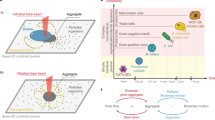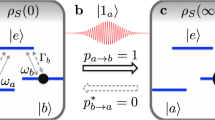Abstract
In a collection of assembling particles that is allowed to reach thermal equilibrium, the energy of a given microscopic arrangement and the probability of observing the system in that arrangement obey a simple exponential relationship known as the Boltzmann distribution. Once the same thermally fluctuating particles are driven away from equilibrium by forces that do work on the system over time, however, it becomes significantly more challenging to relate the likelihood of a given outcome to familiar thermodynamic quantities. Nonetheless, it has long been appreciated that developing a sound and general understanding of the thermodynamics of such non-equilibrium scenarios could ultimately enable us to control and imitate the marvellous successes that living things achieve in driven self-assembly. Here, I suggest that such a theoretical understanding may at last be emerging, and trace its development from historic first steps to more recent discoveries. Focusing on these newer results, I propose that they imply a general thermodynamic mechanism for self-organization via dissipation of absorbed work that may be applicable in a broad class of driven many-body systems.
This is a preview of subscription content, access via your institution
Access options
Subscribe to this journal
Receive 12 print issues and online access
$259.00 per year
only $21.58 per issue
Buy this article
- Purchase on Springer Link
- Instant access to full article PDF
Prices may be subject to local taxes which are calculated during checkout



Similar content being viewed by others
References
Boyer, P. D. The ATP synthase — a splendid molecular machine. Annu. Rev. Biochem. 66, 717–749 (1997).
Bushnell, D. A., Westover, K. D., Davis, R. E. & Kornberg, R. D. Structural basis of transcription: an RNA polymerase II-TFIIB cocrystal at 4.5 angstroms. Science 303, 983–988 (2004).
Xiang, Y. et al. Crystallographic insights into the autocatalytic assembly mechanism of a bacteriophage tail spike. Mol. Cell 34, 375–386 (2009).
Tompa, P. Intrinsically unstructured proteins. Trends Biochem. Sci. 27, 527–533 (2002).
Jarzynski, C. & Langer, J. Equalities and inequalities: irreversibility and the second law of thermodynamics at the nanoscale. Annu. Rev. Condens. Matter Phys. 2, 329–351 (2011).
Pathria, R. K. Statistical Mechanics (Butterworth Heinemann, 2001).
Prigogine, I. & Nicolis, G. Biological order, structure and instabilities. Q. Rev. Biophys. 4, 107–148 (1971).
Spanner, D. Biological systems and the principle of minimum entropy production. Nature 172, 1094–1095 (1953).
Crooks, G. E. Entropy production fluctuation theorem and the nonequilibrium work relation for free energy differences. Phys. Rev. E 60, 2721–2726 (1999).
Jarzynski, C. Nonequilibrium equality for free energy differences. Phys. Rev. Lett. 78, 2690–2693 (1997).
Crooks, G. E. Path-ensemble averages in systems driven far from equilibrium. Phys. Rev. E 61, 2361–2366 (2000).
Hatano, T. & Sasa, S.-i. Steady-state thermodynamics of Langevin systems. Phys. Rev. Lett. 86, 3463–3466 (2001).
Liphardt, J., Dumont, S., Smith, S. B., Tinoco, I. & Bustamante, C. Equilibrium information from nonequilibrium measurements in an experimental test of Jarzynski's equality. Science 296, 1832–1835 (2002).
Trepagnier, E. H. et al. Experimental test of Hatano and Sasa's nonequilibrium steady-state equality. Proc. Natl Acad. Sci. USA 101, 15038–15041 (2004).
Collin, D. et al. Verification of the Crooks fluctuation theorem and recovery of RNA folding free energies. Nature 437, 231–234 (2005).
Esposito, M. & Van den Broeck, C. Three detailed fluctuation theorems. Phys. Rev. Lett. 104, 090601 (2010).
Sivak, D. & Crooks, G. Near-equilibrium measurements of nonequilibrium free energy. Phys. Rev. Lett. 108, 150601 (2012).
Barato, A. C. & Seifert, U. Thermodynamic uncertainty relation for biomolecular processes. Phys. Rev. Lett. 114, 158101 (2015).
England, J. Statistical physics of self-replication. J. Chem. Phys. 139, 121923 (2013).
Landauer, R. Irreversibility and heat generation in the computing process. IBM J. Res. Dev. 5, 183–191 (1961).
Ito, S. et al. Selective optical assembly of highly uniform nanoparticles by doughnut-shaped beams. Sci. Rep. 3, 3047 (2013).
Carnall, J. M. A. et al. Mechanosensitive self-replication driven by self-organization. Science 327, 1502–1506 (2010).
Yokobayashi, Y., Weiss, R. & Arnold, F. H. Directed evolution of a genetic circuit. Proc. Natl Acad. Sci. USA 99, 16587–16591 (2002).
Joyce, G. F. Directed evolution of nucleic acid enzymes. Annu. Rev. Biochem. 73, 791–836 (2004).
Jackel, C., Kast, P. & Hilvert, D. Protein design by directed evolution. Annu. Rev. Biophys. 37, 153–173 (2008).
Kondepudi, D., Kay, B. & Dixon, J. End-directed evolution and the emergence of energy-seeking behavior in a complex system. Phys. Rev. E 91, 050902 (2015).
Jun, J. K. & Hübler, A. H. Formation and structure of ramified charge transportation networks in an electromechanical system. Proc. Natl Acad. Sci. USA 102, 536–540 (2005).
Schaller, V., Weber, C., Semmrich, C., Frey, E. & Bausch, A. R. Polar patterns of driven filaments. Nature 467, 73–77 (2010).
Sanchez, T., Chen, D. T. N., DeCamp, S. J., Heymann, M. & Dogic, Z. Spontaneous motion in hierarchically assembled active matter. Nature 491, 431–434 (2012).
Acknowledgements
The author thanks the Cabot family for its generous support, and A. Bausch and Z. Dogic for helpful discussion.
Author information
Authors and Affiliations
Corresponding author
Ethics declarations
Competing interests
The author declares no competing financial interests.
Rights and permissions
About this article
Cite this article
England, J. Dissipative adaptation in driven self-assembly. Nature Nanotech 10, 919–923 (2015). https://doi.org/10.1038/nnano.2015.250
Received:
Accepted:
Published:
Issue Date:
DOI: https://doi.org/10.1038/nnano.2015.250
This article is cited by
-
Synthesis of causal and surrogate models by non-equilibrium thermodynamics in biological systems
Scientific Reports (2024)
-
Thermodynamic fluctuation theorems govern human sensorimotor learning
Scientific Reports (2023)
-
Inferring scale-dependent non-equilibrium activity using carbon nanotubes
Nature Nanotechnology (2023)
-
Is the maximum entropy production just a heuristic principle? Metaphysics on natural determination
Synthese (2023)
-
Feedback-controlled hydrogels with homeostatic oscillations and dissipative signal transduction
Nature Nanotechnology (2022)



